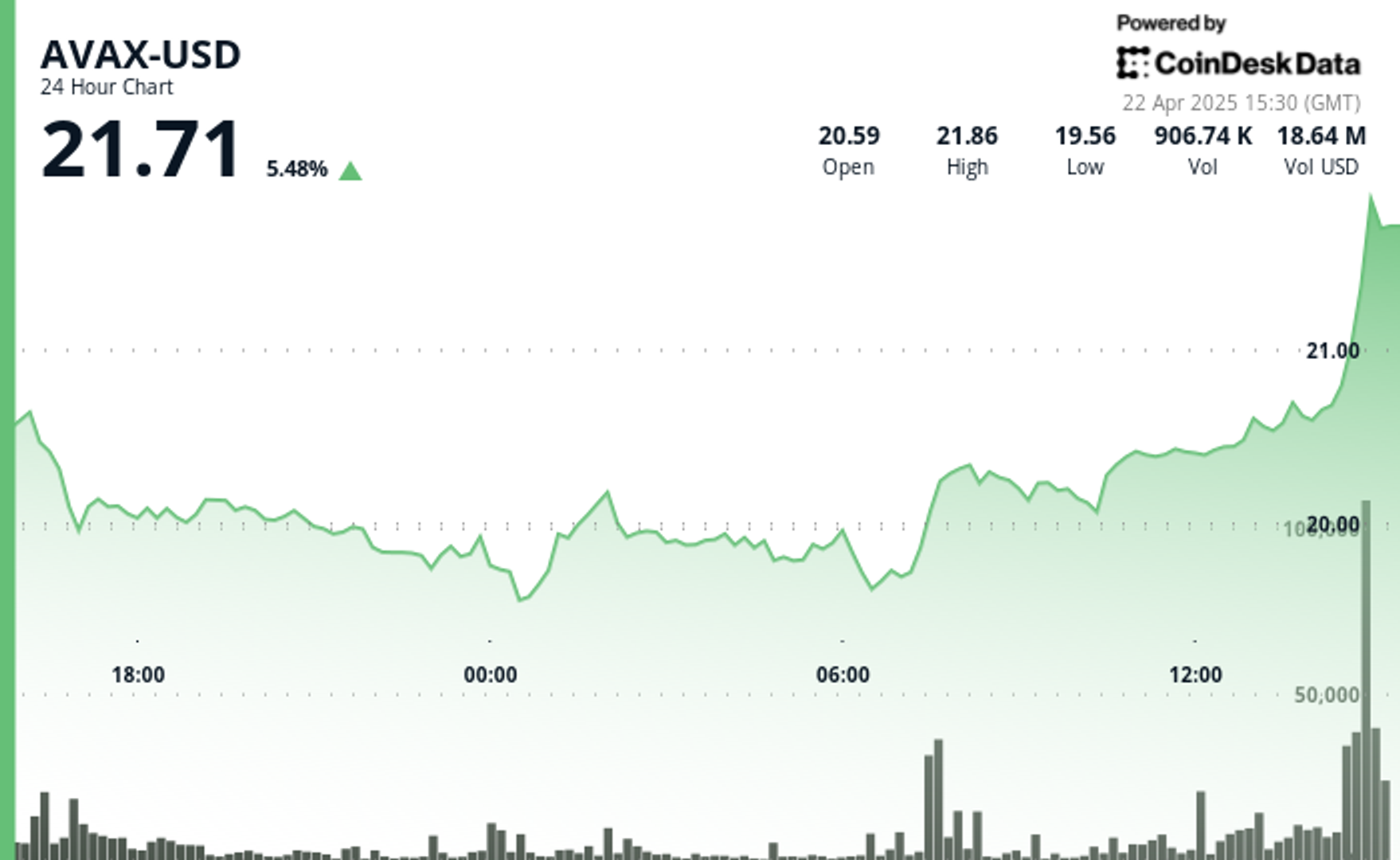Uncategorized
Sell the News: MicroStrategy Plunge Deepens in Days Following Nasdaq-100 Inclusion

In retrospect, it was inevitable.
Down more than 8% and holding just above $300 on Monday, MicroStrategy (MSTR) shares are now lower by about 30% since just after the announcement of their inclusion into the Nasdaq-100 index and nearly 50% from their late November record high.
The signs of at least a major short-term top in one-time barely known enterprise software company turned juggernaut Bitcoin Development Company MicroStrategy were everywhere.
First among those signals was the rocketing stock price — at its high of $543 in late November, MSTR was up nearly eight-fold in 2024 and more than a 50-bagger since the company began buying bitcoin (BTC) in August 2020.
There was also founder and Executive Chairman Michael Saylor — never shy about promoting his company’s prospects and evangelizing for Bitcoin — who late this year had somehow become even more ubiquitous on the financial news, podcast and social media carousels.
It wasn’t just the constant appearances, but subtle changes in Saylor’s attitude to what might charitably be described by U.S. sports fans as «spiking the football» following a touchdown. Among them was the constant promotion of the MicroStrategy-invented key performance indicator of «bitcoin yield,» which recalled late 1990s made-up internet bubble metrics like «page views.» His company flush with cash from share and convertible debt sales, Saylor — for reasons unknown — late in the year also got in the habit of teasing announcements of sizable new bitcoin purchases on the Sunday prior to the official regulatory filing on Monday morning.
And then there was the emergence of copycats. Despite years of the obvious success of Saylor’s bitcoin treasury strategy, there had been a decided lack of other publicly traded corporates adopting the same. Yes, a few — even large-caps like the Elon Musk-led Tesla and Jack Dorsey-led Square — had dipped their toes into bitcoin acquisition. No other company of note, though, was willing to not only adopt bitcoin as their main treasury asset but take advantage of willing markets to raise additional capital with which to accumulate tokens.
That changed in a sizable way this year however, with small cap medical device maker Semler Scientific, Japan hotel operator Metaplanet, and a number of bitcoin miners among those embracing the Saylor vision — each of them earning social media plaudits from Saylor with every capital raise and bitcoin purchase announcement.
If something cannot go on forever, it will stop
Not content with being maybe the greatest trader ever and accumulating many billions of dollars, George Soros wanted to be known as a great thinker. It’s no coincidence that his magnum opus on trading — the Theory of Reflexivity — sounds suspiciously similar to a famous theory from a fellow named Einstein.
Soros explained that investor perception and its effect on prices is a constant two-way street. In this way, perception (which is often wrong, as humans are fallible) can not just influence prices, but literally create its own reality, i.e. 1) investors believe a stock will go higher because earnings are about to get a big boost, 2) the stock price goes higher, 3) the high stock price allows management to raise capital at a cheaper cost than otherwise, 4) this improves earnings, 5) the stock price goes even higher, 6) the bulls pat themselves on the back for their brilliance and win over converts, … and so on.
Strip away much of Soros’ philosophy and this is also known as a virtuous circle, in which MicroStrategy had surely found itself in 2024. Part of Soros’ trading genius was recognizing these circles when they were happening and jumping on — in size. Another part of his genius was figuring out when the circles were about to break and getting out or even betting against them.
«If something cannot go on forever, it will stop,» said the late economist Herb Stein, who at the time was talking about government budget/trade deficits. Stein’s Law, it turns out, was equally applicable to MicroStrategy shares.
Scoreboard: still showing remarkable gains
Changing hands at about $430 just after the Dec. 14 announcement of its coming inclusion into the Nasdaq-100 Index, MicroStrategy is now selling at just above $300, a decline of roughly 30% in just two weeks.
Looking back, there appear to have been cracks in the MicroStrategy bubble three weeks earlier. The stock peaked at about $543 on Nov. 21. Despite bitcoin’s continued rise through late November and early December to an ultimate high above $108,000, MSTR lost ground — what technicians might call a troubling negative divergence. At the current $300, MicroStrategy for the moment is suffering a peak-to-trough drop of 45% in about five weeks.
MSTR shares have still put in a remarkable performance under anything except that very tiny time frame. They remain higher by more than 400% year-to-date and about 20-fold from the time Saylor initiated bitcoin purchases in August 2020.
While the bears might thus say the plunge has far to go, the bulls would surely point out that during MSTR’s run since August 2020, the stock has suffered a number of similar scary short-to-medium term declines and has always resolved higher.
What would Soros say? Just possibly, he would remind that his Theory of Reflexivity taught that prices can go further (both upward and downward) than most could possibly expect.
Uncategorized
AVAX Surges 10.7% as Bullish Breakout Signals Strong Momentum

Avalanche’s AVAX token has broken out of its multi-week correction phase, demonstrating remarkable strength despite ongoing geopolitical tensions affecting cryptocurrency markets.
The broader market gauge, CoinDesk 20 Index (DLCS), has demonstrated exceptional bullish momentum, surging from 1403.33 to 1461.17 in the last 48 hours, representing a 4.12% gain, while the overall range spans 95.56 points (6.97%) from the low of 1365.61 to the high of 1461.17.
The recent price action of AVAX shows accelerated momentum with the formation of a bull flag pattern and decisive breakout above $20.40, coinciding with significant institutional developments in the ecosystem, according to CoinDesk Research’s technical analysis data.
Technical Analysis Highlights
- AVAX demonstrated remarkable strength, surging from 18.87 to 20.89, representing a 10.7% gain.
- Price action reveals a clear bullish trend with higher lows forming a strong support trendline around 19.50.
- After consolidating between 19.30-19.70 on April 20, AVAX experienced a significant breakout on April 21, with volume increasing substantially as the price pushed above 20.00.
- The most recent 48 hours show accelerated momentum with the formation of a bull flag pattern and a decisive breakout above 20.40, suggesting further upside potential.
- Key resistance at 20.90 now becomes the level to watch, with Fibonacci extension targets pointing to 21.50 as the next significant objective.
- In the last 100 minutes, AVAX surged from 20.61 to 21.04, representing a 2.1% gain.
- After consolidating between 20.50-20.60 during the 13:20-13:40 timeframe, price formed a solid base before initiating a powerful upward move.
- The decisive breakout occurred at 14:40 with extraordinary volume (146,387 units), creating a strong support level at 20.80.
- Multiple high-volume candles followed between 14:44-14:48, pushing the price through the critical 21.00 psychological barrier with the highest volume spike (142,112 units) at 14:47.
- This breakout completes the bullish pattern established in the previous 48 hours, with Fibonacci extension targets now suggesting 21.50 as the next significant objective.
Disclaimer: This article was generated with AI tools and reviewed by our editorial team to ensure accuracy and adherence to our standards. For more information, see CoinDesk’s full AI Policy. This article may include information from external sources, which are listed below when applicable.
External References:
- «Avalanche (AVAX), Toncoin (TON) and Kaspa (KAS): Can They Recover?« — CryptoDaily, published April 2025.
- «Avalanche (AVAX), Polkadot (DOT) Rebound on the Horizon? Harmonic Pattern Signals Bullish Move» — Bitzo, published April 2025. — Bitzo, published April 2025. — Bitzo, published April 2025.
- «Avalanche Price Prediction« — Cryptopolitan, published April 2025.
- «Avalanche Card Unveiled: Will It Spark Bullish Momentum for AVAX?« — Coinpedia, published April 2025.
Uncategorized
Janover Buys Another $11.5M in SOL, Gets Renamed Amid Crypto Treasury Strategy Play

Janover (JNVR), the real estate-focused fintech company with a Solana (SOL) treasury strategy, has been renamed to DeFi Development Corp and purchased another $11.5 million worth of SOL tokens, the firm said on Tuesday.
The move brings the company’s total SOL holdings to 251,842, including staking rewards, the company said. That’s valued at around $36.5 million, with SOL currently trading around $145.
JNVR shares were down 2.5% today at $38.3, well below last week’s peak just shy of $80. However, the stock is still up over 800% since adopting the crypto treasury strategy. SOL advanced nearly 5% over the past 24 hours, with the broader crypto market climbing higher.
The purchase was part of the Boca Raton, Florida-based company’s new crypto bet to position itself as the first U.S.-listed company with a treasury strategy centered on Solana and its native token SOL.
As part of the strategy, the firm seeks to accumulate SOL and operate one or more validators to secure the blockchain. The pivot happened after a team of former executives of crypto exchange Kraken bought a majority stake in the firm earlier this month.
Read more: Janover Takes Page From Saylor Playbook, Doubling SOL Stack to $20M as Stock Soars 1700%
The purchase was made using funds from a $42 million financing round the company completed earlier this year. Based on the latest figures, each share of the company represents 0.17 SOL, up 62% from its last crypto purchase, according to the press release.
The firm will also change its ticker to DFSV on the Nasdaq exchange at a future date to reflect its new name.
Last week, the company announced a strategic partnership with Kraken with plans to delegate part of the exchange’s SOL holdings to stake to validators operated by DeFi Development Corp. The firm also teamed up with BitGo to acquire locked tokens via over-the-counter markets.
Uncategorized
Arch Labs Raises $13M in Funding for Bitcoin-Based Smart Contracts

Bitcoin decentralized finance (DeFi) developer Arch Labs raised $13 million in funding toward building «ArchVM,» which the developers say will provide smart-contract functionality on the original blockchain.
The funding round, which valued the company at $200 million, was led by Pantera Capital, according to an announcement on Tuesday.
Arch’s plans to enable decentralized applications and protocols natively on Bitcoin.
ArchVM will handle off-chain computations to enable «Turing-complete smart contracts at the Bitcoin base layer» and provide Solana-like transaction speeds, Arch Labs said in the announcement.
The goal of introducing smart contracts to Bitcoin began to gather steam in October with the release of the BitVM computing language.
Numerous projects are now using BitVM as the basis for bringing smart contracts to Bitvcoin via layer-2 networks or bridges. Arch’s aim is to avoid the need to bridge assets to layer-2s, which could present additional risks.
-

 Fashion6 месяцев ago
Fashion6 месяцев agoThese \’90s fashion trends are making a comeback in 2017
-

 Entertainment6 месяцев ago
Entertainment6 месяцев agoThe final 6 \’Game of Thrones\’ episodes might feel like a full season
-

 Fashion6 месяцев ago
Fashion6 месяцев agoAccording to Dior Couture, this taboo fashion accessory is back
-

 Entertainment6 месяцев ago
Entertainment6 месяцев agoThe old and New Edition cast comes together to perform
-

 Sports6 месяцев ago
Sports6 месяцев agoPhillies\’ Aaron Altherr makes mind-boggling barehanded play
-

 Business6 месяцев ago
Business6 месяцев agoUber and Lyft are finally available in all of New York State
-

 Entertainment6 месяцев ago
Entertainment6 месяцев agoDisney\’s live-action Aladdin finally finds its stars
-

 Sports6 месяцев ago
Sports6 месяцев agoSteph Curry finally got the contract he deserves from the Warriors





